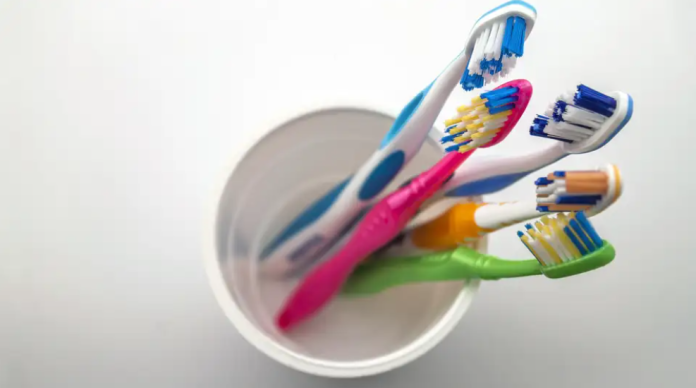There are two types of people in the world. Those who thoughtlessly store their toothbrushes out in the open, in the bathroom that houses a toilet that spews fecal matter (gross, right?), and those who are careful to cover their toothbrushes when not in use, even disinfecting them periodically in the dishwasher or with a sophisticated ultraviolet sterilization device. Of these two groups, guess who follows CDC and ADA recommendations for taking care of their toothbrush? Surprise, it’s the lazy ones.
But aren’t their toothbrushes covered in bacteria and other nasty germs? Of course they are. All toothbrushes are full of germs, and most of them come from our mouths. This review of studies on toothbrush contamination indicates that all “found significant retention and survival of bacteria on toothbrushes after use.”
Toothbrushes start with germs (after all, they are factory cleaned, not sterilized) and quickly pick up any germs you have in your mouth. If you have pathogenic germs in your mouth (gum disease, cold sores), they will stay on the toothbrush and you won’t be able to get rid of them completely. And here’s a fun fact: as toothbrushes age, their surfaces wear down and can harbor even more germs.
Toothbrush germs won’t kill you
Let’s set the record straight before we go any further: while the idea of germs on your toothbrush may scare you, it’s actually not dangerous to most people’s health. The CDC notes that people with bleeding disorders or immunosuppression may need alternative forms of oral hygiene; if this is your case, talk to your doctor. For the rest of us: “The Centers for Disease Control and Prevention is not aware of any adverse health effects directly related to toothbrush use.”
Let your toothbrush dry.
The best way to get rid of all those germs? According to the CDC and the American Dental Association, air-drying is the key.
Rinse the brush with tap water after brushing. This won’t kill bacteria, but it will remove any remaining toothpaste or other residue that may interfere with the drying process. Place the brush on a rack where it can rest and air dry. Drying prevents bacteria from multiplying. If you store used toothbrushes in a container or cover them with a cap, bacteria can multiply more easily. The few germs you keep outside will outnumber the ones that are partying inside.
Learn more about toothbrush care :
Don’t share your toothbrushes with other people; keep leftover body fluids to yourself.
For the same reason, don’t let your toothbrush come into contact with someone else’s toothbrush.
Replace your toothbrush when it becomes frayed, or every three to four months. Toothbrushes clean teeth better (and harbor less bacteria) when they are in good condition.
If the idea of bacteria disgusts you so much that you need to do something, the ADA says you can dip your toothbrush in Listerine or 3% hydrogen peroxide (the kind that comes in the brown bottle at the drugstore). This won’t kill all the bacteria, but it can reduce their numbers by 85% (85% of a billion is still a billion, but maybe that’s reassuring).
Don’t put your toothbrush in the dishwasher or microwave; this may kill bacteria, but it will also damage the toothbrush. Experts seem divided on ultraviolet (UV) light sterilizers. The CDC claims they “can damage” toothbrushes; the ADA acknowledges they exist, but makes no recommendation for or against them.
Is there poop on my toothbrush or not?
What about toilet evaporation? It is true that toilets can release droplets into the air, some of which evaporate into aerosols that float around the room and can settle on your toothbrush or other objects.
However, there are no studies that directly link toilet aerosols to whether toothbrushes make people sick. Instead, we have studies such as this dissertation, which found traces of possible fecal bacteria on 60% of toothbrushes stored in shared bathrooms (the average bathroom was shared by nine people). However, there was no control group in this study; it was not a comparison between toothbrushes stored in bathrooms and toothbrushes stored elsewhere, but simply a study of toothbrushes. (The study also found that bacteria were more common on toothbrushes that were rinsed with mouthwash, suggesting that mouthwash may not be the best way to alleviate your germophobia.)
On the other hand, a project on the microbiome sequenced the microbes on toothbrushes from volunteers across the country and could not find conclusive evidence that the brushes were colonized by fecal bacteria. (Previous studies, including the Ph.D. dissertation, used methods that did not establish with certainty whether the germs came from feces, only that they appeared to belong to the same families as common fecal germs.) “It’s reasonably unlikely that you’ll find bacteria from our feces on your toothbrush,” one of the authors told Gizmodo.










